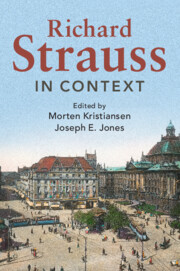Book contents
- Richard Strauss in Context
- Composers in Context
- Richard Strauss in Context
- Copyright page
- Contents
- Figures
- Notes on Contributors
- Preface
- Note on Translation
- Part I Family, Friends, and Collaborators
- Part II Career Stations
- Part III Cultural Engagement and Musical Life
- Part IV Professional and Musical Contexts
- Part V In History
- Part VI Artifacts and Legacy
- Chapter 31 Publishers and Editions
- Chapter 32 Letters
- Chapter 33 In Performance
- Chapter 34 Influence
- Chapter 35 2001: A Space Odyssey and Beyond
- Chapter 36 Scholarly Directions
- Further Reading
- Appendix: Letters Bibliography
- Index
Chapter 33 - In Performance
from Part VI - Artifacts and Legacy
Published online by Cambridge University Press: 08 October 2020
- Richard Strauss in Context
- Composers in Context
- Richard Strauss in Context
- Copyright page
- Contents
- Figures
- Notes on Contributors
- Preface
- Note on Translation
- Part I Family, Friends, and Collaborators
- Part II Career Stations
- Part III Cultural Engagement and Musical Life
- Part IV Professional and Musical Contexts
- Part V In History
- Part VI Artifacts and Legacy
- Chapter 31 Publishers and Editions
- Chapter 32 Letters
- Chapter 33 In Performance
- Chapter 34 Influence
- Chapter 35 2001: A Space Odyssey and Beyond
- Chapter 36 Scholarly Directions
- Further Reading
- Appendix: Letters Bibliography
- Index
Summary
The works of Richard Strauss are now central to the programming and scheduling policies of individual artists, opera houses, orchestras, and recording companies. Whether it be Ein Heldenleben or Salome, Metamorphosen or Ariadne auf Naxos, Eine Alpensinfonie or Der Rosenkavalier, Strauss’s works soon attracted the attention of performers and audiences alike and quickly became barometers of orchestral and vocal excellence. This chapter examines performance data and the ways in which that data reflects trends in Strauss performance. The chapter also looks closely at how Strauss’s oeuvre was framed within an orchestral and operatic context, the shifting responses of conductors, singers, and instrumentalists to his compositions, the ways in which those responses are reflected in the discographies of individual artists, orchestras, and opera companies, and the relationship between Strauss’s works and advances in recording technologies.
- Type
- Chapter
- Information
- Richard Strauss in Context , pp. 302 - 310Publisher: Cambridge University PressPrint publication year: 2020

